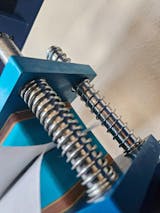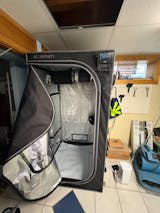1. Why buy HID grow lights?
Despite the ever-growing popularity of LED lights, HID systems are still widely used among growers. That doesn't necessarily mean they are better; many people are just used to them and have been getting great results for a long time.
Here are the main pros and cons of HID systems:
Advantages of HID lights
- the initial cost is much lower than LED and slightly lower than fluorescent
- they have been producing great results consistently for decades
- they have deep light penetration and a great coverage area
Disadvantages of HID lights
- they use much more power than LED or fluorescent grow lights
- they give off much more heat and require an exhaust system
- the bulbs have a shorter lifespan and need to be replaced often
- they need to hang high above the canopy, meaning they require a tall grow space
2. How many watts and lights do I need?
Check out the following table for a rough estimate of your lighting needs. The "Primary Area" is the area in which your plants will enjoy the full benefits of the light. Lights in the "Supplemental Area" will still get some light, but not enough to grow fully. Different reflector styles will affect the coverage area and can increase or decrease it by up to a foot in each direction.
| Bulb Wattage | Primary Area | Supplemental Area |
| 150 watts | 2' x 2' | 3' x 3' |
| 250 watts | 2.5' x 2.5' | 4' x 4' |
| 400 watts | 3' x 3' | 5' x 5' |
| 600 watts | 4' x 4' | 6' x 6' |
| 1000 watts | 5' x 5' | 8' x 8' |
From the table you can see that one 1000w fixture covers a 5' by 5' area, so a 20' by 20' grow space will require sixteen 1000w fixtures or twenty-five 600 watt fixtures. In general, 600w systems are preferable, since they are the most efficient. In the case of this 20 by 20 foot space, I would go with 25x 600 watt lights instead of 16x 1000 watt lights.
3. Single-ended or double-ended?
Double-ended bulbs represent the latest step in HID grow light evolution and they have a number of advantages over single-ended bulbs:
- Most double-ended bulbs still output 90% of their original lumens after 10,000 hours of use. Single ended bulbs get 90% lumen maintenance after just 4000 hours, meaning double-ended bulbs can be run at least twice as long before they need to be replaced.
- Double-ended bulbs are fired from both ends, so the gases inside burn more evenly. This leads to an increased PAR value and a better light spectrum, giving you a higher output.
- The light from DE bulbs has a higher UV content. The arc tube is encases in quartz glass, which is what increases the UV content of the light. The higher UV content leads to improved yields.
- DE bulbs are more stabilized. Single-ended bulbs can begin to sag under their weight in cheaper fixtures, but since DE bulbs are attached at both ends, this never becomes an issue.
The one drawback of double ended systems is their higher initial cost (and their popularity, which means that DE systems are often sold out), but the higher price is more than offset by the improved yields and the much longer lifespan of the bulb.
4. What type of reflector is best?
This depends very much on your needs, but in general, reflectors that are sealed with a glass cover and are air cooled by large ventilation ducts on each end are preferable for smaller, enclosed grow spaces. This way, you can remove the excess heat from the bulb without any of it ever escaping out into your grow space.
Most sealed hoods only have small reflectors, meaning the light is concentrated onto a smaller area of your plants. Thus, the coverage area is relatively small, but the light is more focused and penetrates deep beneath the canopy.
If you want a larger coverage area, go with a larger reflector, like a wing or umbrella reflector. The drawback is that the light does not penetrate nearly as deep. Also, the largest reflectors are not sealed and air cooled.
5. What bulb(s) do I need (MH, HPS or both)?
Ideally you want to use both types of bulbs. Metal-Halide (MH) bulbs give off light similar to sunlight, with a strong blue-spectrum component. This makes them great for the vegetative stage of plant growth, but they do not produce great results during flowering.
High-Pressure Sodium (HPS) bulbs have a strong red-spectrum component, which results in much higher yields during the flowering stage, but causes plants to grow too tall and weak during vegging.
Many experienced growers will use MH bulbs throughout the grow and supplement them with HPS bulbs during the flowering stage. This delivers the best overall results.
Most hobby growers use MH bulbs during veg and switch them out for HPS bulbs during flowering. This leads to good results as well and requires fewer light fixtures.
We have both MH and HPS grow lights for sale individually and in convenient grow kits that include every component you need to light your grow.
If you can only afford one type of bulb, go with HPS. They last longer and deliver better results overall throughout the entire grow. If at all possible, you'll want at least some blue-spectrum light during vegging, so maybe consider fluorescent bulbs to supplement the HPS lights.
6. How far from the canopy should my lights be?
This depends on a number of factors, like the wattage of your bulb and the type of reflector. The individual product pages will have estimates for you, but when you actually hang your lights, go with the instructions included in the box.
If you want a quick estimate, hang your lights this far above the top of the canopy (begin on the high end of the ranges and gradually move the lights closer):
- 1000 watt bulb: 12 to 35 inches
- 600 watt bulb: 10 to 28 inches
- 400 watt bulb: 7 to 21 inches
- 250 watt bulb: 5 to 15 inches
- 150 watt bulb: 4 to 12 inches
Once you've hung your lights, use the "hand test" to check if they are far enough above the canopy. With the lights on, hold your hand palm down near the top of your plants and keep it there for 30 seconds.
If you find the lights too hot for your hand, they are also too hot for your plants and you need to back them off or they will damage the plants. If your hand is fine, move the lights an inch or two closer and test again, until you find the sweet spot (i.e. your hand gets hot, but not uncomfortably so).








